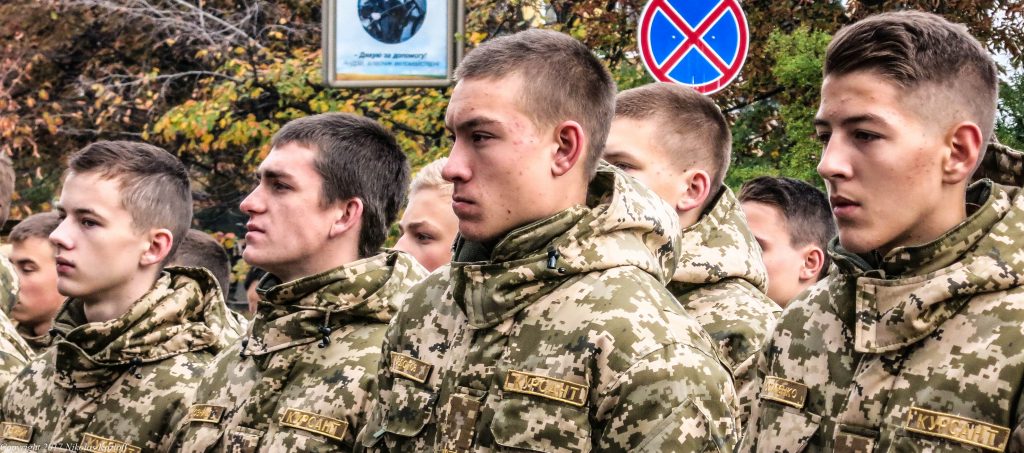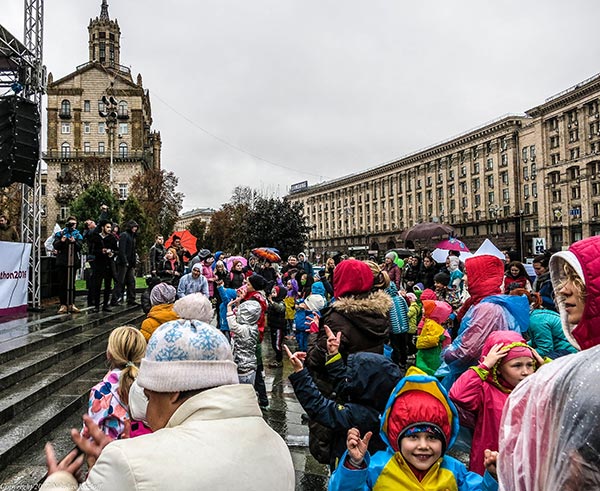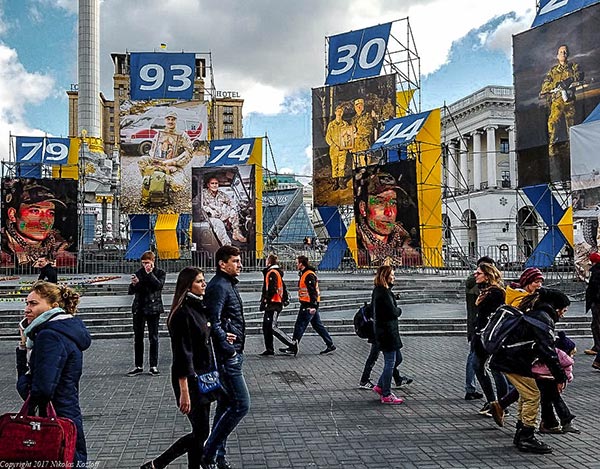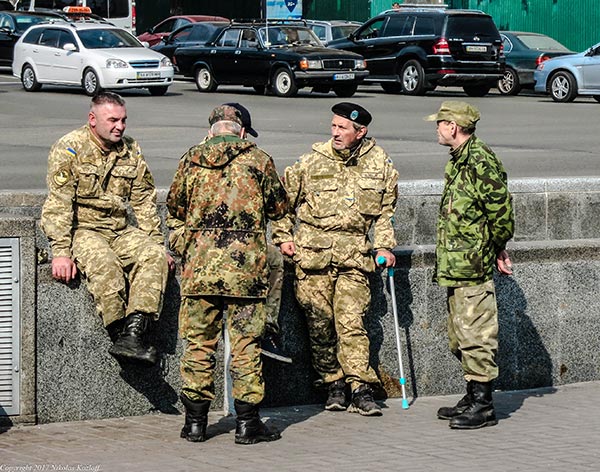
Ukraine’s Secessionist War: a Reappraisal
If you had asked me three years ago to assess Ukraine’s war with Russian-backed separatists in the Donbas region, I would have argued that the conflict had triggered a right-wing shift in the nation’s politics. If anything, military hostilities seemed to have eclipsed or overshadowed radical social change as called for by certain elements within Kyiv’s earlier Maidan revolution. Indeed, many participants who I interviewed for my booklet, Ukraine’s Revolutionary Ghosts, expressed dismay at the rise of right-wing paramilitary groups and forces linked to troubling World War II history and iconography.
Late last year, I returned to Kyiv wondering if my earlier assumptions about the separatist conflict would be borne out or somehow challenged. During the course of my stay I spoke to several veterans and civilian volunteers about their experiences while seeking to maintain an open mind. Since my initial trip, the war had exacted an increasingly heavy toll, with about 10,000 casualties, more than 20,000 injuries and millions displaced in dire need of humanitarian aid. More than three years into the conflict, fighting is ongoing and two peace plans, Minsk I and II, have foundered.
The latter accord called on Russia to relinquish control over separatist territories to Ukraine, which Moscow will never do. Needless to say, though Ukrainian forces are now more seasoned and better-equipped than before, Kyiv lacks sufficient military capability let alone Western backing to take secessionist areas back by force. As a result, both sides are locked in a seemingly endless standoff and the front line has barely moved with artillery exchanges occurring almost every night amidst mounting casualties. In a certain sense, the conflict rekindles memories of World War I but on a smaller scale, featuring tanks, artillery, machine guns, snipers, land mines and trenches.

Civilian-Military Divide
Just how has the war shaken up traditional social conventions? Yavtokia Popovich, a female medic and volunteer, told me the war had placed men and women on an equal social footing on the front lines. Indeed, as women rise up through the ranks and Kyiv’s “G.I. Jane” grabs the spotlight, Ukraine’s traditional gender sphere could be upended or transformed. Yet for me, the question of whether nationalism, let alone right wing paramilitary politics could ever be compatible with feminism remains a somewhat vexing question mark.
And what of the growing chasm between military and civilian leadership: would such divisions give rise to further right-wing nationalism, or perhaps spur on other political forces which have yet to take form? During my conversation with Alexei Cistan, a volunteer who provides supplies to the Ukrainian army, I asked whether the government had assisted or hindered his work. The authorities, he explained, were unhelpful and often pushed regulations which made life more difficult. Moreover, Cistan confirms that corruption interferes with equipment and relief being shipped to conscripts on the front lines.
At one point during the Maidan revolution, a certain “anti-authoritarian” streak could be discerned among the crowd which had grown disgusted with politicians as a whole. And while interpretations may vary as to the ultimate meaning of Maidan protests, what united many demonstrators was an innate struggle against state corruption. Today, it is that same firm reformist drive which may ultimately lead to even further dissension between the military and civilian ranks. According to reports, former revolutionaries who joined the government have grown so disgusted with widespread corruption in military procurement and reform that they have resigned in protest. Even as the war rages in the east, defense contracts have been inflated or doled out to insiders, and corruption reaches the highest levers of power.
Even President Petro Poroshenko has raised eyebrows, since one of his companies has sold boats to the Ukrainian navy. Furthermore, the deputy secretary of Ukraine’s national security and defense council has sold trucks to the army. The official carried out the sale through a motor company where he holds an interest, and the bureaucrat is one of Poroshenko’s business associates. Journalists and whistle-blowers, meanwhile, risk stiff jail time if they dare to disclose such shenanigans. Such high level corruption makes western officials and arms companies jittery, and needless to say there’s already a slight question mark regarding U.S. support for Ukraine in the wake of Donald Trump’s electoral victory.
Psychological Divide
Speaking with Cistan, the growing psychological divide between civilians and the military becomes palpable. Inspired by the Maidan revolution and imbued with a sense of patriotism, Cistan signed up as an independent volunteer with the Ukrainian army. A kind of jack of all trades, he provides everything from food, medicine, clothes and all kinds of supplies to the front line. In day-to-day life, Cistan is a business analyst though he tells me he spends all the money he earns on volunteering activities. Traveling to and from the front line carries considerable risk, and Cistan remarks that he is exposed to mortal danger on a regular basis.
Needless to say, conscripts also face the threat of post-traumatic stress disorder and Cistan has observed that some soldiers returning from the front find it difficult to re-integrate into society. Perhaps, soldiers sense that Kyiv residents are psychologically removed from the day-to-day experience of war. Indeed, life in the capital can seem quite removed from the conflict, with people flocking to ballet theaters, hipster speakeasies or fusion restaurants. Despite the physical and psychological toll of combat, Cistan explains that some conscripts find civilian life so dissatisfying that they head back to the front at the first opportunity.

Constantine Schramko, a corporal in the Ukrainian army, has grown weary of Kyiv’s civilian leadership. A former miner, Schramko hails from the eastern province of Donetsk. Like Cistan, he joined the military after becoming inspired by the Maidan revolution. “I realized that if I did not sign up, then who would protect my country and my house?” Schramko explains. On the one hand, he feels he can trust many soldiers with his life, but on the other hand he has become more suspicious of politicians.

Daily Life on the Front
Needless to say, Kyiv’s bungling of the war has led to recrimination. Popovich, the female volunteer medic, explains that the government hasn’t done a very good job of supplying the military. “If it weren’t for the volunteers,” she asks, “who knows what would have happened?” Though living essentials are in greater supply since the start of the war, civilian volunteers are expected to provide for most of the armed forces’ basic needs. Indeed, the First Mobile Volunteer Hospital relies entirely on civilian donations for its operational survival. Volunteers reportedly ship honey, sugar and coffee to the troops, not to mention more important items such as body armor, boots and underwear. Lack of central support has meant that conscripts have been forced to improvise as best they can. Sergei Scherbina, a soldier serving in Ukraine’s 93rd battalion, is well aware of such pressures: the conscript tells me that on the front lines in Luhansk, his unit has been fighting with outdated weapons from the Soviet invasion of Afghanistan.
Within the U.S. military, specialized units assume responsibility over discrete tasks like engineering, cooking, medical care or the like. Ukrainian troops, however, must forage for food, water or scrap metal and within each unit individual soldiers are tasked with everything from doing the laundry to digging wells and trenches to performing essential tasks such as plumbing or electrical work and repairing radios. Faced with such odds, some soldiers have come to the conclusion that they are seemingly fighting two wars, one against Moscow and the other against their own, inattentive government.

Adding to difficulties, Ukrainian troops and volunteers don’t always receive such a warm welcome from the local civilian population. “We usually don’t get support from local residents,” notes Scherbina. The solider adds that up until recently, many people within the conflict zone lacked access to Ukrainian television, and as a result the population fell under the sway of Russian propaganda. Ironically, some Ukrainian soldiers might even find themselves fighting against old colleagues. In the Soviet era, Schramko served in the military for two years alongside Russian troops. “Even though I served in the Soviet army a long time ago,” he says, “there are still some people fighting on both sides. Indeed, one of my friends is fighting in the Russian army right now.”
Politics of War
“Sometimes when I fall asleep,” Schramko muses, “I dream about going back to civilian life. I want this, but it won’t happen until the war has ended.” Just when the conflict may end, however, is anyone’s guess. Many conscripts say they’re still eager to press on and launch a major offensive to reclaim Ukraine’s lost territories, yet any such effort would prove costly in human life and might damage Kyiv’s international reputation. A more likely scenario, perhaps, is that the conflict will remain frozen in stalemate. “The war is ongoing and rather unpredictable,” notes Cistan. “There will be more deaths and injuries and we can’t do anything about it. The last day I left the front, one of my friends was killed.”
Scherbina is similarly skeptical about the course of the war, let alone peace negotiations. “You can’t address peace until all Russian aggressors are out of Ukraine and Crimea,” he declares defiantly. Soldiers serving on the front lines, he adds, are disappointed that western countries have failed to provide requisite support to Ukraine in its fight against Russian interference. “When Ukraine gave up its nuclear arsenal after the fall of the Soviet Union,” Scherbina exclaims, “Western countries promised to protect our country from aggressors. But now that we are facing a real aggressor, no support is forthcoming.”
During the Maidan revolution, distrust and opposition to governmental authority assumed many forms, including both rightist and leftist political protest. While it is tempting to assume that the war will ultimately encourage the rise of more right-wing politics, Ukraine’s political milieu could become more and more volatile and unpredictable as the war continues to rage in the east. More than three years into the conflict in Donbas, some conscripts as well as their civilian volunteer supporters are questioning Kyiv’s overall handling of the war. If the government is viewed as incompetent, corrupt or not heeding the needs of the soldiers themselves, further dissension within the ranks is probably inevitable.

Leave a comment